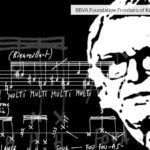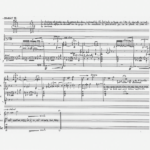Theater made music
Georges Aperghis was born in Athens into a family of artists in 1945, and has lived in Paris since settling there in 1963. His work is characterized by the drive to interrogate language, dissecting its meaning and its evolution, and by the merging of music and theater.

His compositions, whether instrumental, vocal, theatrical or mixed works using music informatics, explore the boundaries of perception and interrelation, creating perceptional illusions that blur the lines between disciplines. His repertoire takes in vocal, orchestral and solo instrumental works, operas and chamber music pieces, most of them inspired by texts or theater.
He was initially drawn to serialism, concrete music (Pierre Schaeffer and Pierre Henry) and the path charted by Xenakis, but Aperghis’ oeuvre does not fit easily with any of the dominant aesthetic currents of contemporary musical creation. Its hallmarks are a dialogue with other art forms and a reaching-out to the other, be they spectator or performer. This alterity sits alongside a restless drive to innovate by bringing machines, automatons, robots and computers onto the theatrical stage.

Georges Asperghis in his studio (Picture by Xavier Lambours)
Since 1997, he has worked with the Atelier de Théâtre et Musique (ATEM) in Bagnolet on the outskirts of Paris. ATEM is a group of actors and performers he co-founded with his wife, actress Édith Scob, where each member participates fully in the creative process. Many of his works, the composer relates, are put together in rehearsal, combining, dividing, transforming and superimposing musical ideas and scenic action, and vice versa. Dance and visual arts have been part of his spectacles from the 1990s onwards.
Europe’s leading contemporary music ensembles – Ictus, Klangforum Wien, Remix, Intercontemporain, Vocalsolisten – have forged and maintained a working relationship with Aperghis through commissions and productions that they have included in their repertoires. In 2000, he received the SACEM Prize for the year’s best composition for Machinations, followed in 2011 by the Mauricio Kagel Prize, and in 2015 by the Golden Lion at the Venice Biennale and this BBVA Foundation Frontiers of Knowledge Award.

Detail of the original manuscript of Les sept crimes de l'amour, Georges Aperghis
Aperghis has traced his own distinctive course along a main highway with multiple byways in present-day musical composition, carved out by composers like Stockhausen (Inori), Ligeti (Aventures and Nouvelles Aventures) – (stage music), Mauricio Kagel (neo-Dadaist instrumental theater) and, in some measure, Helmut Lachenmann and Gérard Grisey who have broken free of the empire of systems. An empire where, as the latter wrote, “the map was more important than the territory,” and the system predominated over the sound itself, its energy, its DNA and the emotions held within it.
Aperghis has ceaselessly reinvented his personal language. An artist of his time, he has taken different dimensions of contemporary creation and melded them in his work – a permeability to other arts that enables him to explore new expressive, visual, scenic, optical, digital and temporal avenues. His oeuvre thus becomes the total artwork in which every element from the macro form to the smallest rhythmic or expressive pattern creates a multi-dimensional counterpoint, allowing the spectator to navigate, or drift, in a universe of emotions, aural and otherwise.
I take time to rehearse my works, so I can lose myself then find myself again together with the performers — Aperghis
Aperghis’ uniqueness lies in the use of non-linear logic or rhizomatic thought (Deleuze and Guattari); that is, the application of a compositional model where the organization of the elements does not respond to a hierarchical order. Instead, each component of the structure may inform the conception, evolution and transformation of any other, whatever their reciprocal position.
The absence of a center in the rhizome makes it relevant for social philosophy, the philosophy of science, semiotics and contemporary communication theory; a relevance Aperghis now extends to music. This is evident in the approach he takes with L’Origine des espèces (1993), where the formal, creative process echoes the evolution or journey of life from protozoa to man.
The processing and modification of phonemes is a constant in Aperghis’ work. Pieces like Six tourbillons (1989) or Machinations (2000) reflect his interest in displaying and modifying the expressive content of each phoneme, probing the roots of language with regard to emotions and gesture, while testing the limits of its transformation, virtuosity and combinability in both the splitting and rearranging of the text and the alteration of its meaning.
This metamorphosis finds maximum expression in Machinations, employing techniques of computer-assisted composition (CAC) whereby numerical voice samples are subjected to granular synthesis in what we might metaphorically describe as vocal microsurgery, combining and densifying ad infinitum minute particles of consonants, vowels, moans and screams… which combine with whole consonants, vowels, phonemes, words and phrases to create a broad multi-temporal vocal fabric that is also a thing of beauty.
For the musicalization of disciplines less abstract than music (theater, image, stage, etc.), Aperghis has recourse to an extremely precise musical language. This is not just theatrical staging, it is the staging of a score through movements, actions, gestures, textures, etc., written with keen rhythmic precision in time and space, which overthrow all perceptions of what we call a concert.
The way he conceives his work entails a renewal of the acts of performing, listening, and producing for the stage, so the actors in each case are able to evolve within their roles.